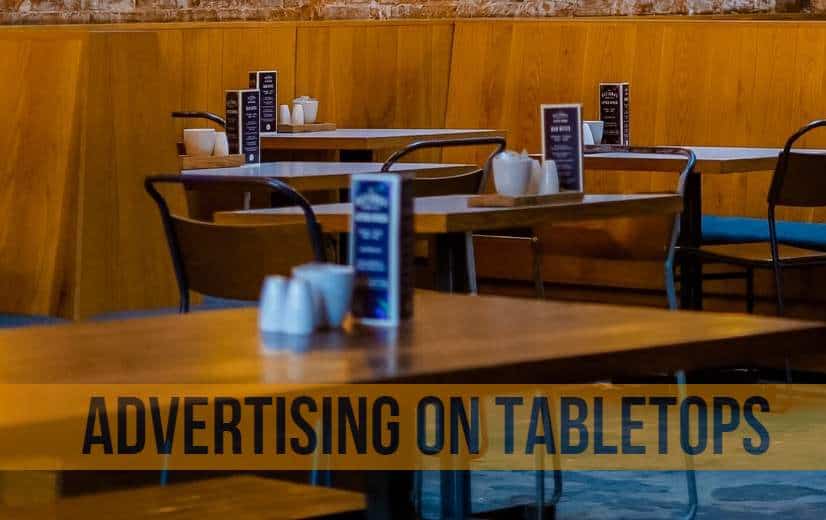Placemat and tabletop ads are use unique consumer psychology principles to engage consumers in a low-stress, high-attention environment: restaurants. Diners who sit at a table are a captive audience, influencing their behavior and making them more susceptible to the brand messages in front of them.
Tabletop Ad: Behavioral Influence and Consumer Psychology
Captive Audience with Focused Attention
Unlike many advertising mediums where the customer is on the move—whether driving past billboards, scrolling through social media or watching TV—restaurant diners are generally immobile and waiting. This wait time provides a natural opportunity for ad exposure, particularly when customers await lunch or chat with few interruptions. Consumer attention research suggests that when people are waiting, they are more inclined to focus on their immediate surroundings. Placemat ads leverage on this by holding a patron’s attention for an extended time, sometimes 15 to 30 minutes. The consumer’s natural desire to examine their surroundings while waiting improves the possibility of ad exposure. This behavior arises from the brain’s need to be attentive and active, especially in unknown environments. Diners may subconsciously draw toward the placemat as a point of visual engagement. Over time, repeated watching can leave a lasting imprint, cementing the brand in the consumer’s consciousness even if they are not actively engaged with it.
The Power of Boredom and Repetition
Another psychological phenomenon that placemat ads capitalize on is the function of boredom in driving engagement. When customers have nothing to do while waiting for their meals, they are more inclined to focus on their surroundings, especially the advertising in front of them. Boredom serves as a drive, causing people to seek out stimulation, even through advertisements. This effect boosts the ad’s memorability. Placemat ads, combined with the principle of repetition, ensure that diners view the message several times in a short time. Repetition in advertising is a well-established strategy for increasing brand recall and awareness. According to consumer psychology studies, the more frequently people see an advertisement, the more familiar it becomes, resulting in favorable associations with the company and higher trust. The calm environment of a restaurant ensures that consumers are exposed to the same ad several times, without feeling intrusive.
Incidental Learning and Subconscious Messaging
Placemat advertisements also use the notion of incidental learning. Even when diners aren’t actively paying attention to the ad, their brains digest it. This form of passive learning can be quite successful. Research demonstrates that individuals are more likely to retain information delivered in a nonintrusive manner during inactive moments, such as waiting for a meal. This unconscious processing of the ad results in a situation in which the consumer becomes acquainted with the brand or product without feeling compelled to interact. The ads are perfectly interwoven into the dining experience, resulting in higher recall and a more favorable view of the company than more aggressive, intrusive advertising.
Social Interaction and Word of Mouth Influence
Diners rarely eat alone, especially at family-friendly restaurants, making social interaction an essential element of the dining experience. Placemat advertisements have the unique potential to start talks among groups. For example, someone may remark on an ad or discuss the advertised brand, resulting in word-of-mouth engagement. Word-of-mouth marketing has traditionally been regarded as one of the most effective forms of promotion, as customers trust recommendations from their peers more than traditional adverts. By employing placemat advertising to stimulate conversations, brands may organically extend their message’s reach, increasing impressions and influence among social groups.
Emotional Context of Dining and Positive Associations
Dining out is frequently associated with positive emotions such as relaxation, enjoyment, and socialization. This emotional context improves the efficiency of placemat advertising because consumers are more likely to create positive connections with businesses they see in a pleasant setting. The notion of emotional priming is applied here. Consumers are more likely to react positively to the brands they encounter when they are in a good mood. An enjoyable dining experience might transmit these positive sensations to the advertisements in front of them, resulting in the halo effect. This effect improves the likelihood of the buyer remembering the brand in a positive light and being more motivated to make a purchase later.

To understand the reasons tabletop is a preferred advertising method, we look at advantages of using the approach when advertising. Keep reading to discover.
Another top reason for advertising on tabletops is that it puts the advert in front of the target audience. If you are targeting university students, the secret is to identify the restaurants they are likely to visit. Print advertisements and place them strategically to increase the chances of interacting with the ad.
How to Estimate the ROI of Tabletop Advertising?
Impressions and Reach: To estimate restaurant placemat advertising reach and monthly impressions, we must consider the projected number of daily visitors per restaurant, the duration of the advertising campaign, and the number of placemats utilized throughout the service. The average restaurant has 300 to 500 customers daily, depending on location, size, and kind (casual vs. fine dining). Assuming 6-8 views per table, placemat advertising impressions are calculated for every diner who spends 15 to 30 minutes at the table. Thus, monthly impressions would be 60-120,000.
Tabletop Advertising: Advertiser Use Cases
Local doctors, dentists, clinics
Use Case: A dentist advertises children’s dental services on placemats in family-friendly restaurants. The ad may include a QR code for an online appointment booking system that offers kids a reduced first visit. Parents can schedule appointments while eating.
Objective: Promote family dental care locally.
Benefit: Targets families dining out, making it easy for parents to schedule a checkup.
Fitness centers, gyms
Use Case: A local gym advertises free workout trials on placemats at a health-conscious café. The ad offers 10% off the first month of gym membership when signed up online.
Goal: Increase memberships through direct action and incentives.
Benefit: The health-focused setting appeals to guests’ fitness and wellness interests, enhancing conversion.
Realty Agencies
Use Case: A real estate agent advertises open houses and seminars at a busy neighborhood diner with tabletop advertisements. QR codes go to a webpage where buyers can register for updates.
Objective: Generate local property buyer/seller leads.
Benefit: Targeted, hyper-local advertising lets agents reach community people who may be moving.
Auto Repair Shops
Use Case: An auto repair company advertises a seasonal car check-up deal on diner tabletops (e.g., winter tire change, oil change reductions). Diners should contact or book online, according to the ad.
Objective: Encourage local car owners to schedule maintenance.
Benefit: Local auto shops are convenient and likely to attract local drivers, making this a fantastic way to reach them.
🍽️ Advertise where the focus is real and the audience is hungry! With placemat ads, your message gets 15-30 minutes of full attention while diners wait for their meals. Why settle for a fleeting billboard glance when you can have engagement over dinner? 💡






